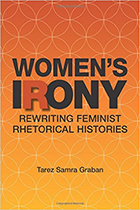
In her new book, Women's Irony: Rewriting Feminist Rhetorical Histories (Southern Illinois UP, 2015), Tarez Samra Graban examines some conventional characterizations of irony but she also argues for a redefinition of the concept, especially in how histories get written of women's rhetorical performances.
"I am promoting a kind of criticism that relies on rhetoric as—historically—a written tradition," Graban says. "In my introduction I raise the question 'Why irony?' Why am I promoting irony as a paradigm for historiography in rhetoric and what does that mean? The chapters move progressively from there, and each chapter is simultaneously a chapter about feminist recovery and some aspect of irony that I'm trying to argue for."
 Graban uses three case studies, spanning 1600 to 1900, to guide her process as she makes her case.
Graban uses three case studies, spanning 1600 to 1900, to guide her process as she makes her case.
Anne Askew was an English writer and a Protestant Reformation figure who was burned at the stake for heresy. Anne Hutchinson was born in England but is an early American figure, well known in the Boston Puritan church before she was excommunicated for questionable teaching. Graban's third case study, Helen Gougar, was a suffragist from Indiana who helped secure municipal suffrage in several Western states prior to 1910.
"Each one serves as a case study for me to demonstrate some nuance about the critical and reflective possibilities of irony," Graban says. "So, you could say in a way that the whole book is redefining irony… Not just as a trope, not just as a strategy, but as a paradigm… a way of thinking rhetorically about history."
Graban writes in her introduction that Women's Irony "does not offer a single response to the questions of why and how women rhetors have used irony in their political discourse. Instead, it presents irony as a useful form of ideological disruption then and now, argues for the complex and contradictory uses for which it has been put, and demonstrates its potential for redefining agency, language, and history."
The ideas that Graban presents in her book began during her PhD program at Purdue. One of her history of rhetoric courses introduced her to Renaissance women rhetors, and she developed interest in a few specific questions: "How have women used irony in these recurrent political situations? How do our assumptions about how irony works cause us to write certain histories of them? And then, could we be wrong?"
Humor studies was another one of her research topics at the time, and she became fascinated in irony as a political tool and cultural strategy. Archival studies fueled her interest in methodology.
"It seemed as if when I read historical analyses of women's texts, irony often appeared or irony was part of the analysis," she says. "That got me interested in how have we relied on it as a critical lens to tell these stories that we now take to be the authoritative histories of how women have participated in rhetorical studies. Could there have been room for ambiguity? Were we taking a notion of irony that had been established with other people in mind and were we trying to apply that to these women? Should we not consider irony as a function of our archive?"
As she continued to research and write Women's Irony, Graban became interested in transnational feminism and how women heads of state have either used irony tropes or been perceived as being ironic—especially those high-ranking women referred to as "Iron Ladies."
"This book was borne out of my wanting to examine all of that and to determine whether 'Iron Lady' is the best way to historicize women heads of state and elected diplomats or whether we need to give up that trope," Graban says.
To illustrate her approach, Graban uses well-circulated and well-problematized statements by contemporary women rhetors, such as former prime minister of Israel Golda Meir. One of her comments, published in the July 1969 US edition of Vogue magazine, read, "We, Israel, don't thrive on military acts, we do them because we have to and thank God we're efficient."
"I realized that irony played a large part in how Meir's statements were excerpted and then moved through a popular medium," Graban says, adding that she focused on the statements' ambiguities and complexities. "Irony is not just contained within this statement; it provokes greater questions: On what basis might she be saying that? Where is her cultural loyalty? What is the exact subject she speaks of? Whom does she represent? Is this a statement about the people of Israel or does it reflect Israel's public perception as a nation?"
Rebecca Jones, associate professor and director of English Graduate Studies at the University of Tennessee at Chattanooga, appreciates that Graban went beyond a straightforward exploration of irony. She writes, "Women's Irony would be an excellent work even if it only offered a compelling, nuanced, and radically new discussion of the ironic public rhetoric of three bold, historical women… However, Graban adds another provocative layer: a call to action for feminist historiographers. In reviving 'consciousness raising' as part of the historiographer's job, Graban mandates an additional task after sifting through the archives: 'unsettling the ways in which the narratives are remembered.'"
Katherine H. Adams, professor and chair of the English department at Loyola University New Orleans, lauds Graban for breaking new ground, writing that Women's Irony is "the first study to employ history and theory to focus on how irony might shape an influential text and how it might influence readers of different time periods."
Writing a book and getting it published is never easy, and Graban had her own obstacles during the process.
"Some of the early resistance to the book was people saying 'that's not my notion of irony,'" she says. "I did stick pretty closely to a semantic and pragmatic definition of irony because I was dealing with transcripts. But what I tried to do was spend a lot of time showing how fluid those factors are, particularly when examining someone in the 21st century looking back at something someone in the 20th century wrote about someone in the 17th century."
Graban says that in the beginning it felt like she was contending with two projects—a historical study and a theoretical treatise, separated into chapters for the historical aspects and interchapters for the theoretical discoveries that she wanted people to understand. Eventually, in response to her editors' suggestions, she collapsed the book.
"[It] became a move through these historical case studies, where each case study is helping me build theory about how irony functions," she says. "I wanted my work to be a little on the edges of things. I think it still is a little bit on the edges of things."
Graban's next book project has the working title Rhetoric, Irony, and Transnational Feminism. She will focus more on troubling the "Iron Lady" trope as a historical device and on "trying to determine what it tells us about how we write histories, should it be replaced, and does it function equally when applied to women in these positions from different geographical regions?"
Among the leaders she hopes to examine are Indira Gandhi, Ellen Johnson Sirleaf (the current president of Liberia), and Golda Meir.
"The figures that I want to study are challenging historically, because they either led with bicultural status or they reflected what I call a third-culture status," Graban says. "I am fascinated by women whose political statuses and cultural statuses are seen as hybrid and I wonder if their labeling as 'Iron Ladies' has anything to do with that hybridity."
Graban plans to continue some of her research in South Africa. She has been collaborating with two African rhetoric scholars, and in early 2015, she was invited to be a research fellow with the Department of English at the University of South Africa. For the next three years, she will be an informal collaborator with scholars there.
"When you do work in transnational feminist rhetoric, it really benefits you to go to the locations you study," Graban says. In contrast to her first book, which entailed readings of many histories about women rhetors—"I did have to manage a big conversation in Women's Irony but it was not a live or moving conversation"—Rhetoric, Irony, and Transnational Feminism will be a live conversation.
"I don't think I will ever be able to know enough to fully account for the whole transnational conversation, so I have to choose my piece of it," Graban says.

